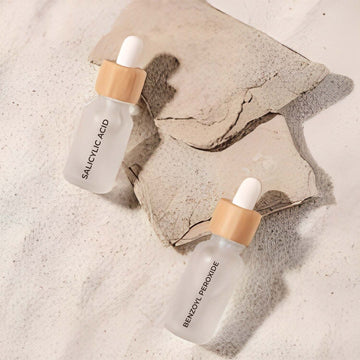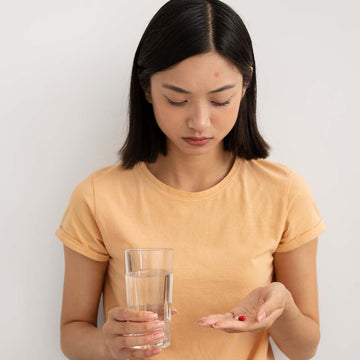Acne, a common companion through teenage years into adulthood, prompts many to seek effective treatments. Salicylic acid and benzoyl peroxide, easily accessible in various products, offer solutions for mild to moderate acne.
1.Salicylic Acid: The Gentle Exfoliator
a.Benefits of Salicylic Acid:
salicylic acid, a natural exfoliant found in aspirin, promotes skin cell turnover, preventing pimple formation. Studies lean towards its effectiveness, especially against blackheads and whiteheads.
b.Considerations and Side Effects:
While generally well-tolerated, salicylic acid may cause redness, inflammation, dryness, and peeling. Caution is advised for those allergic to aspirin.
2.Benzoyl Peroxide: The Bacterial Battler
a.Benefits of Benzoyl Peroxide:
Considered the most effective over-the-counter acne-fighting ingredient, benzoyl peroxide not only removes excess oil and dead skin cells but also combats acne-causing bacteria beneath the skin.
b.Considerations and Side Effects:
Effective but potentially causing peeling, redness, burning, and irritation. Higher concentrations increase the likelihood of side effects. Individuals allergic to benzoyl peroxide should avoid products containing it.
3.Choosing the Right Treatment
Factors to Consider:
1.Acne Type: Salicylic acid for blackheads and whiteheads, benzoyl peroxide for mild pustules.2.Breakout Severity: Quick results for benzoyl peroxide emergency spot treatment.
3.Activity Level: Consider nighttime use for benzoyl peroxide to avoid staining clothing.
4.Skin Sensitivity: Salicylic acid suits sensitive skin better than benzoyl peroxide.
5.Medical Conditions: Check with a doctor if you have underlying skin conditions or medical issues.
4.Proper Usage Guidelines
To maximize effectiveness and minimize side effects:
1.Rotate Ingredients: use salicylic acid or benzoyl peroxide in every step of your routine.2.Sunscreen: Apply daily to prevent worsening of acne and protect against potential side effects.
3.Salicylic Acid Dosages: Concentrations typically range from 0.5% to 5%, suitable for morning and night application.
4.Benzoyl Peroxide Dosages: Start with 2.5% concentration and increase if needed. Apply up to twice per day.
5.Can They Be Used Together?
While your treatment plan may include both ingredients, using them on the same skin area, even at different times is a part of good skincare routine. A safer approach is to have recourse to each for different types of acne—salicylic acid for overall treatment and benzoyl peroxide as a targeted spot treatment.
6.Conclusion
No absolute cure for acne exists, but the battle can be effectively waged with the right allies. Salicylic acid and benzoyl peroxide, with their unique strengths, offer relief and clearer skin. If results are elusive after six weeks, consulting a dermatologist for personalized recommendations is advisable.
To know more click here.
FAQ "Frequently Asked Questions."
1. What is acne and why is it common during teenage years and adulthood?Acne is a common skin condition characterized by the presence of pimples, blackheads, and whiteheads. It often occurs during teenage years and into adulthood due to hormonal changes.
2. How do salicylic acid and benzoyl peroxide help in treating acne?Salicylic acid and benzoyl peroxide are effective in treating acne by promoting skin cell turnover, preventing pimple formation, and combating acne-causing bacteria.
3. What are the specific benefits of salicylic acid for the skin?
Salicylic acid acts as a gentle exfoliator, particularly effective against blackheads and whiteheads.
4. Are there any considerations and side effects of using salicylic acid?
While generally well-tolerated, salicylic acid may cause redness, inflammation, dryness, and peeling. Caution is advised for those allergic to aspirin.
5. How does benzoyl peroxide combat acne, and what makes it effective?
Benzoyl peroxide is considered the most effective over-the-counter acne-fighting ingredient as it removes excess oil, dead skin cells, and combats acne-causing bacteria beneath the skin.
6. What considerations and side effects should be kept in mind when using benzoyl peroxide?
Benzoyl peroxide can potentially cause peeling, redness, burning, and irritation. Higher concentrations increase the likelihood of side effects, and individuals allergic to it should avoid related products.
7. How should one choose the right acne treatment between salicylic acid and benzoyl peroxide?
The choice depends on factors such as acne type, breakout severity, activity level, skin sensitivity, and any underlying medical conditions. Consulting a doctor is advisable for personalized recommendations.
8. What are the proper usage guidelines for salicylic acid and benzoyl peroxide to minimize side effects?
Guidelines include rotating ingredients, applying sunscreen daily, using recommended dosages, and being cautious about concentrations to prevent worsening of acne and potential side effects.
9. Can salicylic acid and benzoyl peroxide be used together in an acne treatment plan?
While both ingredients may be part of a treatment plan, using them on the same skin area, even at different times, may lead to excessive drying and irritation. It's safer to utilize each for different types of acne.
10. Is there an absolute cure for acne, and when should one consult a dermatologist for acne-related concerns?
There is no absolute cure for acne, but effective management is possible. If results are elusive after six weeks, consulting a dermatologist for personalized recommendations is advisable.





